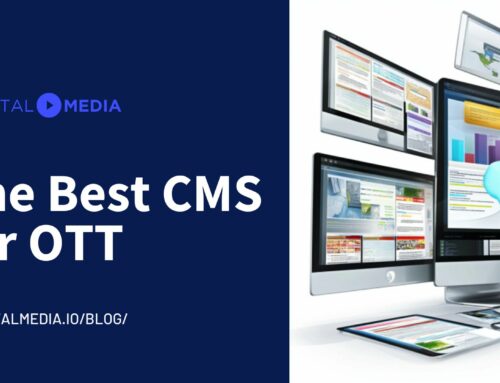The streaming industry and OTT (Over-The-Top) platforms are undergoing a rapid transformation, driven by changes in consumer habits, technological innovation, and the growing demand for on-demand content.
As more users choose streaming services over traditional television, the sector continues to evolve to meet this increasing demand. By 2025, several key trends are expected to not only reshape the digital entertainment landscape but also influence how audiences interact with content. These trends will range from advanced personalization and the use of artificial intelligence to the global expansion of platforms and the creation of exclusive original content, redefining the way we consume audiovisual media in the near future.
What are the main trends expected for 2025?
The OTT (Over The Top) market is projected to reach $1.99 trillion by 2029, with an annual growth rate of 28.19%. Personalized content, live sports streaming, and competition among platforms will drive market evolution. However, content piracy remains a significant challenge.
Let's take a look at the trends that will shape the market over the coming months:
- Growth in fragmentation and competition
The expansion of new OTT platforms, each with exclusive content, will likely continue, leading to greater market fragmentation. We can expect mergers and acquisitions between platforms to consolidate content and reduce costs, as seen with major media companies.
- Rise of FAST channels
Experts predict that FAST (Free Ad-Supported Streaming TV) advertising revenue in the U.S. will reach $6 billion by 2025, surpassing cable TV, broadcasting, and even subscription-based streaming platforms (SVOD/AVOD). This represents a new revenue stream for OTT platforms, requiring innovative ad formats that do not disrupt the viewing experience. Visit our article: What are FAST channels?
- Advanced personalization
By 2025, personalization will go beyond simple content recommendations. OTT platforms will use AI algorithms and machine learning to create detailed user profiles, considering viewing habits, preferences, and even real-time mood analysis. This level of personalization will ensure that users receive content suggestions tailored specifically to their tastes, increasing engagement and satisfaction.
- Augmented reality or interactive content
Today's viewers don't just want to watch content—they want to be part of the action. The integration of Augmented Reality (AR) and Virtual Reality (VR) on OTT platforms will expand, allowing for immersive experiences. For example, gaming features may be integrated into streaming platforms, enabling users to make decisions that affect the storyline or interact with the content creatively, such as real-time voting, challenges, or rewards.
This type of content will be crucial for attracting and retaining users. By offering more immersive experiences, viewers feel a stronger personal connection to what they're watching, fostering greater emotional engagement and motivating continued platform use.
- Rise of local content and microcontent
OTT platforms will increasingly focus on producing local and regional content to attract specific audiences, particularly in emerging markets. Content reflecting cultural diversity will become more common as platforms seek to broaden their global appeal and connect with diverse audiences. Additionally, short-form content, such as brief videos and "light" programs, will gain prominence, addressing the reality of shrinking attention spans.
- Multichannel and omnichannel experience
Users will continue to demand the ability to consume content across various devices (smartphones, tablets, smart TVs, consoles, etc.). OTT platforms will be compelled to optimize the experience on each of these channels, ensuring a seamless and fluid user experience across devices.
- Live streaming and sports events
Live streaming, especially for sports events, will become a key growth area. In addition to sports, other live experiences such as concerts, product launches, or interactive events will gain popularity, drawing large audiences and creating new monetization opportunities.
- Regulation and privacy
With the growing influence of OTT platforms, increased government regulation is expected, particularly regarding data privacy, copyright protection, and the safeguarding of local content. If you want to learn how to combat deepfake videos, visit this article.
- Monetization of new content forms
With the rise of non-fungible tokens (NFTs), platforms could begin exploring the sale of exclusive or collectible digital content, offering users new ways to own and experience media content.
In addition to traditional subscriptions, new monetization models could emerge, such as premium live experiences, early access to content, or even microtransactions within interactive content, meaning users will be able to purchase products featured in the content directly from the app.
These trends reflect a dynamic and evolving market where technology, consumer behavior, and business strategies intertwine to shape the future of OTT platforms and the streaming industry in 2025.

Why should you learn about our tech solution?
Fractal Media, with over 10 years of experience in developing video technology solutions, has established itself as an industry leader in media, providing OTT platforms, multi-device applications, cloud CDN services, and digital marketing solutions. With offices in Madrid and Miami, our company offers comprehensive solutions to over 100 businesses, covering the entire video lifecycle, from encoding to distribution and data analytics.
Our flagship product, Fractal ATOM, is a modular platform that integrates advanced content management functions, from video ingestion to multi-device delivery. The platform offers high compatibility with other systems, allowing seamless integration with CDNs, CMSs, and third-party analytics tools. At Fractal Media, we are also pioneers in Smart TV application development, having published over 60 apps for leading manufacturers like Samsung and LG.
We stand out for creating efficient OTT solutions, using proprietary technology that ensures robustness and cost optimization for our clients. Our CDN guarantees fast video delivery, with less than half a second latency for playback initiation, handling up to 6 million monthly streams.
Additionally, our CMS, Fractal ATOM, enables complete and personalized content management, supporting multiple languages, automatic subtitles, and AI-based recommendation tools. It also integrates DRM solutions and security systems compliant with GDPR, ensuring data protection and content security.
At Fractal Media, we continue to innovate, offering solutions tailored to the specific needs of our clients, from mobile applications to Smart TV integrations and live streaming systems, always delivering high-quality user experiences and top-tier technical support.
Want to learn more? Contact us with no obligation.
What opportunities does diversification into the video content industry offer digital newspapers?
- User Engagement: Video tends to attract and retain user attention more effectively than text or static images, thereby enhancing advertising opportunities and boosting user retention.
- Monetization: This is an additional revenue stream that ensures financial sustainability in an increasingly competitive environment.
- Real-Time News Coverage: Video and live broadcasts allow digital newspapers to cover news in real time more immediately.
- Competition and Differentiation: In a highly competitive digital environment, including video content can be a strategy to differentiate and stand out among various offerings. Providing a wider range of content formats can attract different audience segments.
The integration of video content by digital newspapers can include everything from news and reports to entertainment and analysis. It is a natural evolution as media outlets seek to meet the changing demands of their audience and adapt to the ever-changing digital landscape.
What should you consider when creating your own OTT TV channel?
Here is a basic guide to help you start your own OTT channel:
- Identify your target audience and define the type of content you want to offer. It could be entertainment, news, education, or a combination of several genres.
- Analyze other OTT channels in your niche to understand what works and what doesn't. Observe their content strategies, user interface, and monetization options.
- Decide how you will monetize your channel. You can opt for advertising, subscriptions, in-app purchases, sponsorships, or a combination of these options.
- Choose the technological platform that fits your needs. You can check out the best options on the market in this article.
- Organize your programming coherently and ensure you have an attractive and varied content library.
- Customize your OTT channel's user interface. Make sure it's easy to navigate and provides an engaging user experience.
- Streaming quality is key to retaining your audience. Ensure your content streams smoothly and in HD quality.
- Consider offering streaming on multiple devices, such as mobile phones, tablets, smart TVs, etc.
- Use digital marketing strategies to promote your channel. Utilize social media, email marketing, and other tactics to reach your target audience.
- Use analytics tools to evaluate your channel's performance. Measure metrics such as user retention, viewing time, and content interaction. Learn from this data and adjust your strategy as needed.
Remember that the success of your OTT channel will largely depend on the quality and relevance of your content, as well as the ease of use of your platform.
Choosing the right platform will depend on your specific needs and the scope of your video content distribution project. It is essential to thoroughly evaluate the advantages and disadvantages of each solution before making a decision. At Fractal Media, we will be happy to advise you and present our technological solution. Contact us.




